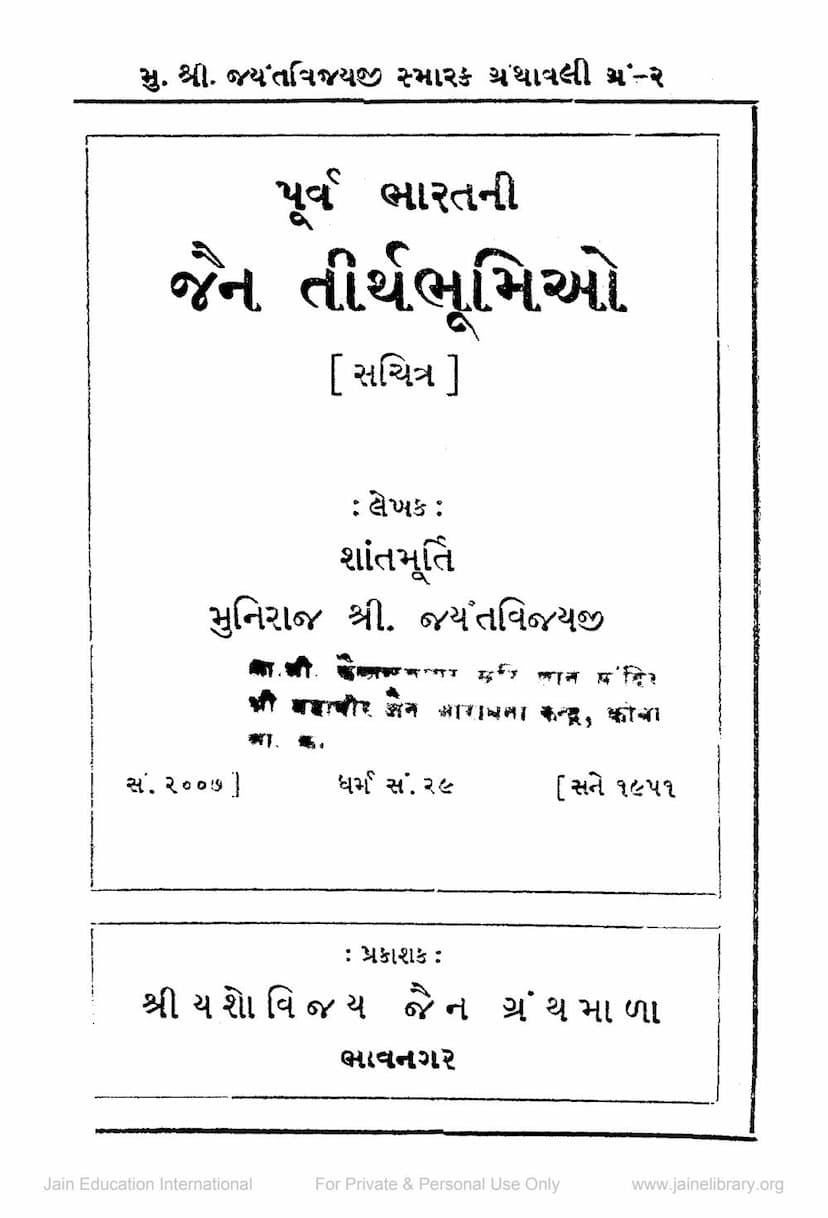Purva Bharatni Jain Tirth Bhumio
Added to library: September 2, 2025

Summary
The book "Purva Bharatni Jain Tirth Bhumio" (Jain Pilgrimage Sites of East India) by Jayantvijay, published by Yashovijay Jain Granthmala in 1951, is a comprehensive guide to Jain pilgrimage destinations in Eastern India. It serves as a travelogue and historical account, detailing the significance of these sacred sites for Jain pilgrims.
Key aspects and themes covered in the book:
- Author's Motivation and Vision: The book is presented as a tribute to the author's late guru, Muni Shri Jayantvijayji Maharaj, who had envisioned and collected material for this work. The publisher expresses gratitude to the disciples and supporters who helped bring this project to fruition.
- Content and Scope: The book covers a total of 55 villages and towns, providing a brief introduction to each. It includes information on the pilgrimage route, the nearest railway stations for accessing the sites, and details about historical events and figures associated with each location.
- Historical and Religious Significance: The author emphasizes the deep historical and religious importance of these sites, many of which are associated with the lives and teachings of Jain Tirthankaras, particularly Lord Mahavir Swami, who is said to have spread Jainism in these regions.
- Detailed Descriptions of Pilgrimage Sites: The book provides detailed descriptions of numerous Jain pilgrimage sites, including:
- Major Destinations: Agra, Mathura, Shauripur, Kampilyapur, Kausambi, Gaya, Bhadlilpur, Isri (Parasnath Hill), Madhuvan, Sammed Shikhar, Pawapuri, Kundalpur (Nalanda), Rajgir, Vaishali, Kakandi, and many others.
- Architectural and Artistic Features: The descriptions often include details about the architecture of the Jain temples, their sculptures, and artistic elements, such as the meenakari work at Kanpur and the glass temple in Calcutta.
- Historical Events and Legends: The book recounts historical events, legends, and miracles associated with these sites, often highlighting the patronage of royalty and wealthy merchants in the construction and maintenance of temples.
- Changes Over Time: The author notes the decline and abandonment of some ancient sites due to historical events and the influence of other religions, while also celebrating the preservation and revival efforts.
- Travel and Practical Information: The book aims to be a practical guide for pilgrims, offering information on travel routes, railway stations, and amenities available at each location.
- Illustrations: The book is enriched with approximately 18 pictures of various pilgrimage sites, making it more engaging and informative.
- Dedication and Acknowledgements: The book is dedicated to the memory of Upadhyay Shri Mangalvijayji Maharaj, a learned disciple of Acharya Shri Vijaydharmasurishwarji Maharaj. The publishers also express their gratitude to various individuals and institutions who supported the publication, including Seth Shri Purushottamdas Surachand Vora for his financial assistance.
- Challenges and Future Endeavors: The publishers acknowledge the loss of Muni Shri Jayantvijayji Maharaj's guidance and the challenges faced in publishing subsequent works due to financial constraints. They appeal for support from well-wishers to continue their mission of promoting Jain literature and culture.
- Jain Culture and Heritage: The book implicitly highlights the rich Jain cultural heritage, its philosophical underpinnings (like Ahimsa and Anekant), and its historical evolution in Eastern India. It underscores the importance of preserving this heritage for future generations.
In essence, "Purva Bharatni Jain Tirth Bhumio" is a valuable resource for anyone interested in the history, geography, and spiritual significance of Jain pilgrimage sites in Eastern India. It is a meticulously researched and passionately presented work that aims to guide and inspire Jain pilgrims while preserving the legacy of these sacred places.